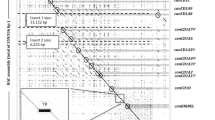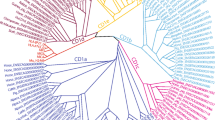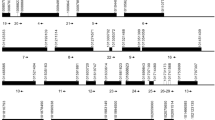Abstract
The CD1 family is a group of non-polymorphic MHC class I-like molecules that present lipid-based antigens to T cells. Previous work in our laboratory demonstrated that cytotoxic T lymphocytes from immune adult horses recognize lipids from the cell wall of an important equine pathogen, Rhodococcus equi. These findings suggest an important role for the equine CD1 antigen presentation system in protective immune responses to microbial pathogens in the horse. In this study, we characterized and mapped the equine CD1 gene cluster. The equine genome was found to contain 13 complete CD1 genes; seven genes were classified as homologues of human CD1a, two CD1b, one CD1c, one CD1d, and two CD1e, making it the largest CD1 family to date. All but one of the eqCD1 molecules were expressed in all antigen-presenting cells investigated. The major amino acid differences between equine CD1 isoforms are located in the predicted antigen binding site, suggesting that a variety of lipid antigens can be presented. R. equi survives and replicates within professional phagocytes by arresting phagosome maturation between the early endosome and late phagosome. Based on the absence of a tyrosine sorting motif in all eqCD1a, CD1a molecules are predicted to co-localize with R. equi in the early endosome. Here, they could acquire lipid antigen and present it to T lymphocytes. The extraordinarily large number of CD1 molecules in the horse may reflect their crucial role in immunity to R. equi.



Similar content being viewed by others
References
Altschul SF, Gish W, Miller W, Myers EW, Lipman DJ (1990) Basic local alignment search tool. J Mol Biol 215:403–410
Au-Yeung BB, Fowell DJ (2007) A key role for Itk in both IFN gamma and IL-4 production by NKT cells. J Immunol 179:111–119
Barral D, Brenner M (2007) CD1 antigen presentation: how it works. Nat Rev Immunol 7:929–941
Borg N, Wun K, Kjer-Nielsen L, Wilce M, Pellicci D, Koh R, Besra G, Bharadwaj M, Godfrey D, McCluskey J, Rossjohn J (2007) CD1d-lipid-antigen recognition by the semi-invariant NKT T-cell receptor. Nature 448:44–49
Bricard G, Porcelli S (2007) Antigen presentation by CD1 molecules and the generation of lipid-specific T cell immunity. Cell Mol Life Sci 64:1824–1840
Calabi F, Jarvis JM, Martin L, Milstein C (1989) Two classes of CD1 genes. Eur J Immunol 19:285–292
Cernadas M, Cavallari M, Watts G, Mori L, De Libero G, Brenner MB (2010) Early recycling compartment trafficking of CD1a is essential for its intersection and presentation of lipid antigens. J Immunol 184:1235–1241
Cohen NR, Garg S, Brenner MB (2009) Antigen presentation by CD1 lipids, T cells, and NKT cells in microbial immunity. Adv Immunol 102:1–94
Coles MC, Raulet DH (2000) NK1.1+ T cells in the liver arise in the thymus and are selected by interactions with class I molecules on CD4+ CD8+ cells. J Immunol 164:2412–2418
Dascher C, Hiromatsu K, Xiong X, Morehouse C, Watts G, Liu G, McMurray D, LeClair K, Porcelli S, Brenner M (2003) Immunization with a mycobacterial lipid vaccine improves pulmonary pathology in the guinea pig model of tuberculosis. Int Immunol 15:915–925
Dascher CC, Brenner MB (2003) Evolutionary constraints on CD1 structure: insights from comparative genomic analysis. Trends Immunol 24:412–418
de la Salle H, Mariotti S, Angenieux C, Gilleron M, Garcia-Alles L, Malm D, Berg T, Paoletti S, Maître B, Mourey L, Salamero J, Cazenave J, Hanau D, Mori L, Puzo G, De Libero G (2005) Assistance of microbial glycolipid antigen processing by CD1e. Science 310:1321–1324
Elewaut D, Lawton AP, Nagarajan NA, Maverakis E, Khurana A, Honing S, Benedict CA, Sercarz E, Bakke O, Kronenberg M, Prigozy TI (2003) The adaptor protein AP-3 is required for CD1d-mediated antigen presentation of glycosphingolipids and development of Valpha14i NKT cells. J Exp Med 198:1133–1146
Fernandez-Mora E, Polidori M, Lührmann A, Schaible UE, Haas A (2005) Maturation of Rhodococcus equi-containing vacuoles is arrested after completion of the early endosome stage. Traffic 6:635–653
Garcia-Alles LF, Giacometti G, Versluis C, Maveyraud L, de Paepe D, Guiard J, Tranier S, Gilleron M, Prandi J, Hanau D, Heck AJ, Mori L, De Libero G, Puzo G, Mourey L, de la Salle H (2011) Crystal structure of human CD1e reveals a groove suited for lipid-exchange processes. Proc Natl Acad Sci U S A 108:13230–13235
Hammond S, Horohov D, Montelaro R (1999) Functional characterization of equine dendritic cells propagated ex vivo using recombinant human GM-CSF and recombinant equine IL-4. Vet Immunol Immunopathol 71:197–214
Harris S, Fujiwara N, Mealey R, Alperin D, Naka T, Goda R, Hines S (2010) Identification of Rhodococcus equi lipids recognized by host cytotoxic T lymphocytes. Microbiology 156:1836–1847
Hiromatsu K, Dascher C, LeClair K, Sugita M, Furlong S, Brenner M, Porcelli S (2002) Induction of CD1-restricted immune responses in guinea pigs by immunization with mycobacterial lipid antigens. J Immunol 169:330–339
Jackman RM, Stenger S, Lee A, Moody DB, Rogers RA, Niazi KR, Sugita M, Modlin RL, Peters PJ, Porcelli SA (1998) The tyrosine-containing cytoplasmic tail of CD1b is essential for its efficient presentation of bacterial lipid antigens. Immunity 8:341–351
Kawashima T, Norose Y, Watanabe Y, Enomoto Y, Narazaki H, Watari E, Tanaka S, Takahashi H, Yano I, Brenner M, Sugita M (2003) Cutting edge: major CD8 T cell response to live bacillus Calmette-Guérin is mediated by CD1 molecules. J Immunol 170:5345–5348
Kelly BT, McCoy AJ, Späte K, Miller SE, Evans PR, Höning S, Owen DJ (2008) A structural explanation for the binding of endocytic dileucine motifs by the AP2 complex. Nature 456:976–979
Looringh van Beeck FA, Zajonc DM, Moore PF, Schlotter YM, Broere F, Rutten VP, Willemse T, Van Rhijn I (2008) Two canine CD1a proteins are differentially expressed in skin. Immunogenetics 60:315–324
Martin LH, Calabi F, Lefebvre FA, Bilsland CA, Milstein C (1987) Structure and expression of the human thymocyte antigens CD1a, CD1b, and CD1c. Proc Natl Acad Sci U S A 84:9189–9193
Maruoka T, Tanabe H, Chiba M, Kasahara M (2005) Chicken CD1 genes are located in the MHC: CD1 and endothelial protein C receptor genes constitute a distinct subfamily of class-I-like genes that predates the emergence of mammals. Immunogenetics 57:590–600
Patton K, McGuire T, Fraser D, Hines S (2004) Rhodococcus equi-infected macrophages are recognized and killed by CD8+ T lymphocytes in a major histocompatibility complex class I-unrestricted fashion. Infect Immun 72:7073–7083
Patton K, McGuire T, Hines M, Mealey R, Hines S (2005) Rhodococcus equi-specific cytotoxic T lymphocytes in immune horses and development in asymptomatic foals. Infect Immun 73:2083–2093
Porcelli S, Morita C, Brenner M (1992) CD1b restricts the response of human CD4-8- T lymphocytes to a microbial antigen. Nature 360:593–597
Porcelli SA (1995) The CD1 family: a third lineage of antigen-presenting molecules. Adv Immunol 59:1–98
Rahman M, Herron L, Kapur V, Meijer W, Byrne B, Ren J, Nicholson V, Prescott J (2003) Partial genome sequencing of Rhodococcus equi ATCC 33701. Vet Microbiol 94:143–158
Rodionov DG, Nordeng TW, Kongsvik TL, Bakke O (2000) The cytoplasmic tail of CD1d contains two overlapping basolateral sorting signals. J Biol Chem 275:8279–8282
Salamero J, Bausinger H, Mommaas AM, Lipsker D, Proamer F, Cazenave JP, Goud B, de la Salle H, Hanau D (2001) CD1a molecules traffic through the early recycling endosomal pathway in human Langerhans cells. J Invest Dermatol 116:401–408
Sieling PA, Chatterjee D, Porcelli SA, Prigozy TI, Mazzaccaro RJ, Soriano T, Bloom BR, Brenner MB, Kronenberg M, Brennan PJ (1995) CD1-restricted T cell recognition of microbial lipoglycan antigens. Science 269:227–230
Silk J, Salio M, Brown J, Jones E, Cerundolo V (2008) Structural and functional aspects of lipid binding by CD1 molecules. Annu Rev Cell Dev Biol 24:369–395
Sugita M, Cao X, Watts GF, Rogers RA, Bonifacino JS, Brenner MB (2002) Failure of trafficking and antigen presentation by CD1 in AP-3-deficient cells. Immunity 16:697–706
Sugita M, Jackman RM, van Donselaar E, Behar SM, Rogers RA, Peters PJ, Brenner MB, Porcelli SA (1996) Cytoplasmic tail-dependent localization of CD1b antigen-presenting molecules to MIICs. Science 273:349–352
Ulrichs T, Moody D, Grant E, Kaufmann S, Porcelli S (2003) T-cell responses to CD1-presented lipid antigens in humans with Mycobacterium tuberculosis infection. Infect Immun 71:3076–3087
Wade CM, Giulotto E, Sigurdsson S, Zoli M, Gnerre S, Imsland F, Lear TL, Adelson DL, Bailey E, Bellone RR, Blöcker H, Distl O, Edgar RC, Garber M, Leeb T, Mauceli E, MacLeod JN, Penedo MC, Raison JM, Sharpe T, Vogel J, Andersson L, Antczak DF, Biagi T, Binns MM, Chowdhary BP, Coleman SJ, Della Valle G, Fryc S, Guérin G, Hasegawa T, Hill EW, Jurka J, Kiialainen A, Lindgren G, Liu J, Magnani E, Mickelson JR, Murray J, Nergadze SG, Onofrio R, Pedroni S, Piras MF, Raudsepp T, Rocchi M, Røed KH, Ryder OA, Searle S, Skow L, Swinburne JE, Syvänen AC, Tozaki T, Valberg SJ, Vaudin M, White JR, Zody MC, Lander ES, Lindblad-Toh K, Platform BIGS, Team BIWGA (2009) Genome sequence, comparative analysis, and population genetics of the domestic horse. Science 326:865–867
Watanabe Y, Watari E, Matsunaga I, Hiromatsu K, Dascher C, Kawashima T, Norose Y, Shimizu K, Takahashi H, Yano I, Sugita M (2006) BCG vaccine elicits both T-cell mediated and humoral immune responses directed against mycobacterial lipid components. Vaccine 24:5700–5707
Yu CY, Milstein C (1989) A physical map linking the five CD1 human thymocyte differentiation antigen genes. EMBO J 8:3727–3732
Zajonc DM, Elsliger MA, Teyton L, Wilson IA (2003) Crystal structure of CD1a in complex with a sulfatide self antigen at a resolution of 2.15 A. Nat Immunol 4:808–815
Zeng Z, Castaño AR, Segelke BW, Stura EA, Peterson PA, Wilson IA (1997) Crystal structure of mouse CD1: an MHC-like fold with a large hydrophobic binding groove. Science 277:339–345
Acknowledgments
We acknowledge the technical assistance of David Herndon and Siddra Hines. We thank Emma Karel and Casey Lawson for their animal handling expertise. Special thanks to Wendy Brown and Robert Mealey for manuscript review. This work was funded by Morris Animal Foundation Grant D10EQ-046 and by United States Department of Agriculture-Agricultural Research Service 5348-32000-034-00D.
Conflict of interest
The authors declare that they have no conflict of interest and all animal studies have been approved by the appropriate ethics committee experiments and comply with the current laws of the country in which the experiments were performed.
Author information
Authors and Affiliations
Corresponding author
Electronic supplementary material
Below is the link to the electronic supplementary material.
ESM 1
(DOCX 797 kb)
Rights and permissions
About this article
Cite this article
Dossa, R.G., Alperin, D.C., Hines, M.T. et al. The equine CD1 gene family is the largest and most diverse yet identified. Immunogenetics 66, 33–42 (2014). https://doi.org/10.1007/s00251-013-0741-6
Received:
Accepted:
Published:
Issue Date:
DOI: https://doi.org/10.1007/s00251-013-0741-6




